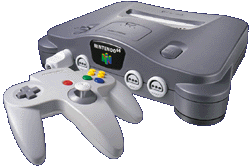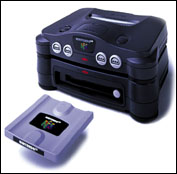

the first writable bulk data storage
device for a modern video game
console. Using a 64 megabyte
writable magnetic disk media, it will
allow game developers freedom to
store unprecedented amounts of
gaming data on a console machine.
For example, it could be used to
track every stat you can imagine in a baseball game, or every detail
about the world and your character in an RPG or simulation game.
The Nintendo 64
Disk Drive can be used for future upgrades of
games by providing
new levels or characters.
Nintendo 64 Disks
will be bootable, meaning that they can be used
without a cartridge
in the system (although they can also be used in
conjunction with
a cartridge).
The Nintendo 64
Disk Drive is planned to include a 4 megabyte
RDRAM upgrade for
the Nintendo 64, which will bring the total
RDRAM for the N64
system up to 8 megabytes total, more than
any console game
system.
The Nintendo 64
Disk Drive hardware will also contain a built-in
ROM with some helpful
data files that can be accessed by Nintendo
64 Disk Drive developers.
In addition, the Nintendo 64 Disk Drive
hardware has a
real-time clock.
Speed:
The Nintendo 64
Disk Drive will read data at about one megabyte
per second, which
is roughly comparable to a 6X PC CD-ROM
drive. Sega Saturn
and Sony Playstation sport 2X CD-ROM drives,
which only transfer
about 300 kB/sec.
Details:
The Nintendo 64
Disk Drive unit sits underneath the Nintendo 64
console and plugs
into the EXT. expansion connector on the bottom
of the system.
The Nintendo 64
Disk Drive uses a disk that is physically about the
size of a 3.5 floppy
disk, but is twice as thick.
Because of the potential
for exposure to very young children, the
Nintendo 64 Disk
Drive drive itself has many ruggedizing features.
For example, it
has a locking bay drive door that will not open
unless two small
rails on the Nintendo 64 Disk are inserted into it.
This will keep
little fingers and cookies out of the Nintendo 64 Disk
Drive. The Nintendo
64 Disk itself also has a durable case and locks
up tight when not
in the drive.
A variable amount
of the space on the Nintendo 64 Disk can be
designated as readable
(ROM) or writable (RAM). There are
several different
ways the data can be divided between readable and
writable, ranging
from a split of 38 megabytes writable and 26
megabytes readable,
to having the entire disk's 64 megabytes of
memory read only.
Although a cost
for the Nintendo 64 Disks has not been announced,
it will be less
expensive from a manufacturing standpoint than the
cost of cartridges.
The Nintendo 64
Disk Drive is a "burst access" device. This means
that it does not
stream data to the N64, but rather sends it in high
speed bursts. Because
of this, the Nintendo 64 Disk Drive will not
be ideal for full
motion video, or for streaming audio data (although
clever developers
will of course find ways to create FMV effects
with the system).
However, with the powerful 3D polygon
capabilities of
the N64, it is just as effective to create 3D real-time
movies with polygonal
characters.
On the Development
Side:
The Nintendo 64
Disk gives the developer up to 64 megabytes for
code and data (compared
to the 8-12 megabytes of currently
available N64 cartridge
configurations).
The 8 megabytes
of RDRAM will allow for large frame buffers and
custom sound wave
tables in RAM.
With the Nintendo
64 Disk Drive's writable capability, the game can
save extensive
amounts of customization data or tons of stats.
SimCity has been
mentioned as a possible game that could make use
of this extended
writable memory.
The Nintendo 64
Disk Drive's capabilities create three ideal game
development scenarios.
The first scenario makes use of the
expanded RDRAM
of the system and is ideal for a racing game with
multiple tracks
or an RPG. In these kinds of games, where the basic
program code is
not too large, but the tracks and world maps are, a
developer could
put the code in the RDRAM, and then load the
different tracks
or world maps off of the Nintendo 64 Disk Drive as
they are encountered.
Another scenario
would be to use the Nintendo 64 Disk Drive for a
game with many
different levels that have different game play. In this
case, the program
code and the level data would be loaded into
RDRAM from the
Nintendo 64 Disk Drive at the beginning of each
level.
Another scenario,
that may be used for Zelda 64, is to use the
Nintendo 64 Disk
Drive to create future expansions for a cartridge
based game. This
allows the developer or publisher to release their
game immediately,
and then give it extra long life with expansion
disks. This can
easily be done if the "hooks" for the Nintendo 64
Disk Drive are
put into the cartridge program in advance.